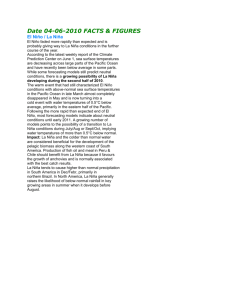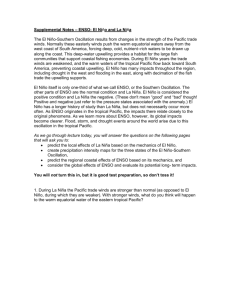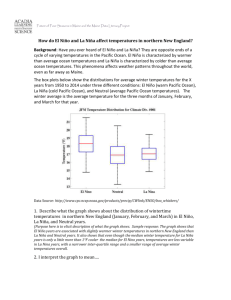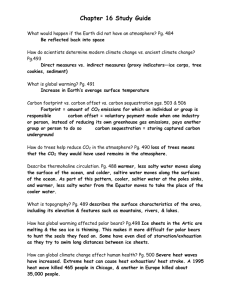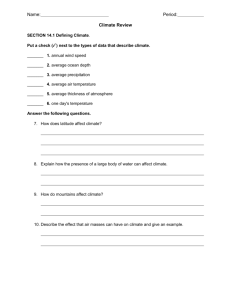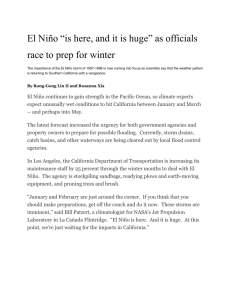weather and climate: what`s the difference
advertisement
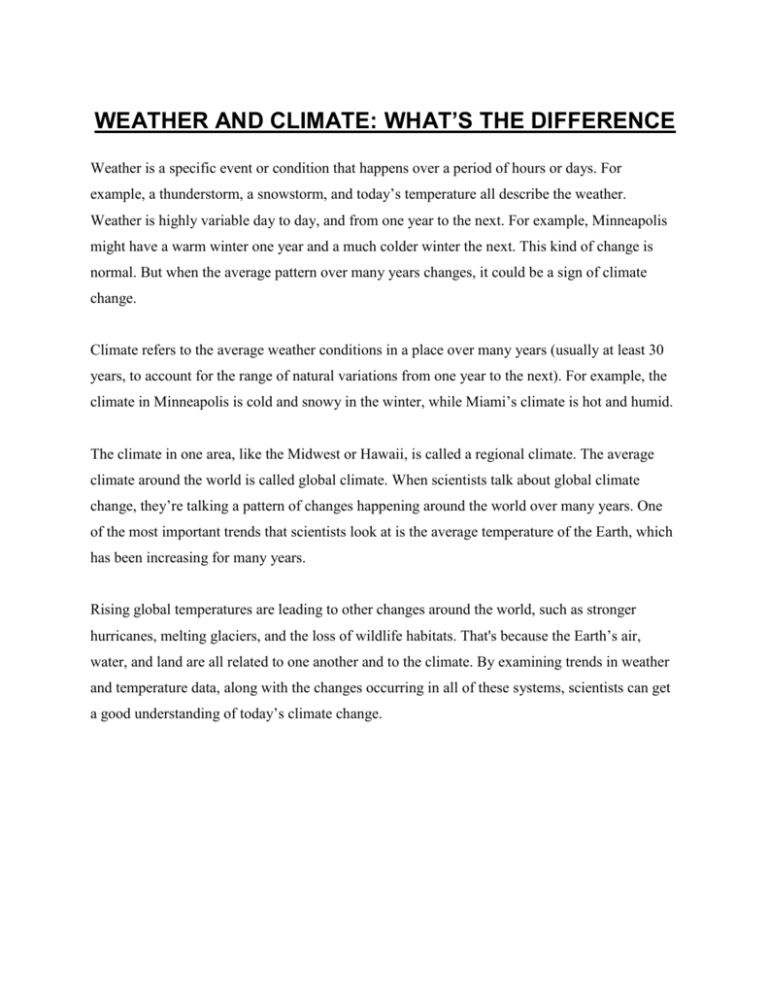
WEATHER AND CLIMATE: WHAT’S THE DIFFERENCE Weather is a specific event or condition that happens over a period of hours or days. For example, a thunderstorm, a snowstorm, and today’s temperature all describe the weather. Weather is highly variable day to day, and from one year to the next. For example, Minneapolis might have a warm winter one year and a much colder winter the next. This kind of change is normal. But when the average pattern over many years changes, it could be a sign of climate change. Climate refers to the average weather conditions in a place over many years (usually at least 30 years, to account for the range of natural variations from one year to the next). For example, the climate in Minneapolis is cold and snowy in the winter, while Miami’s climate is hot and humid. The climate in one area, like the Midwest or Hawaii, is called a regional climate. The average climate around the world is called global climate. When scientists talk about global climate change, they’re talking a pattern of changes happening around the world over many years. One of the most important trends that scientists look at is the average temperature of the Earth, which has been increasing for many years. Rising global temperatures are leading to other changes around the world, such as stronger hurricanes, melting glaciers, and the loss of wildlife habitats. That's because the Earth’s air, water, and land are all related to one another and to the climate. By examining trends in weather and temperature data, along with the changes occurring in all of these systems, scientists can get a good understanding of today’s climate change. GETTING TO THE CORE: THE LINK BETWEEN TEMPERATURE AND CARBON DIOXIDE Since the start of the Industrial Revolution around 1750, people have burned large amounts of coal, oil, and natural gas to power their homes, factories, and vehicles. Today, most of the world relies on these fossil fuels for their energy needs. Burning fossil fuels releases CO2, a heattrapping gas, into the atmosphere, which is the main reason why the Earth’s climate is getting warmer. Heat-trapping gases are also called greenhouse gases. They exist naturally in the atmosphere, where they help keep the Earth warm enough for plants and animals to live—a phenomenon called the greenhouse effect. By adding more greenhouse gases to the atmosphere, however, people are contributing to an enhanced greenhouse effect and causing the atmosphere to trap more heat than it otherwise would. The Earth’s climate has changed many times before. There have been times when most of the planet was covered in ice, and there have also been much warmer periods. Over at least the last 650,000 years, temperatures and CO2 levels in the atmosphere have increased and decreased in a cyclical pattern. The Earth’s temperature has also experienced a similar cyclical pattern characterized by glacial and interglacial periods. During glacial periods (more commonly called ice ages), the Earth has experienced a widespread expansion of ice sheets on land. Intervals between ice ages, called interglacial periods, have brought higher temperatures. The Earth has been in an interglacial period for more than 11,000 years. Historically, temperature and CO2 have followed similar patterns because the heating or cooling of Earth’s surface can lead to changes in the concentrations of greenhouse gases in the atmosphere, which can then cause additional warming or cooling. For hundreds of thousands of years, the concentration of CO2 in the atmosphere stayed between 200 and 300 parts per million (ppm). Today, it’s up to nearly 400 ppm, and the amount is still rising. Along with other greenhouse gases, this extra CO2 is trapping heat and causing the climate to change. Before people had thermometers, indeed before any temperatures were recorded, the Earth itself recorded clues about temperature, precipitation, atmospheric gases, and other aspects of the environment in the thick layers of ice that have accumulated in places like Greenland and Antarctica. To reveal these clues to the past, researchers drill into glaciers and ice sheets and remove cylinder-shaped samples of ice called ice cores. Back in the laboratory, scientists can use chemical sampling techniques to determine the age of each layer of ice and the concentrations of different gases trapped in tiny air bubbles within the ice, which reveals the composition of the atmosphere in the past. They can also examine the water molecules in the ice itself to get information about historical temperatures. Trapped pollen and dust provide additional clues about the climate. Ice core records can go back hundreds of thousands of years, and they help scientists find out whether the rapid increase in CO2 levels and temperature we are currently observing fits a natural pattern or not. Investigating the Earth’s air temperature and the amount of CO2 in the atmosphere over a long time period helps us to better understand the Earth’s carbon cycle, its relationship to the greenhouse effect, and its role in regulating the Earth’s climate. El Niño and La Nina: The El Niño-Southern Oscillation (ENSO) is a global coupled ocean-atmosphere phenomenon. El Niño and La Nina are important temperature fluctuations in surface waters of the tropical Pacific Ocean. ENSO is associated with floods, droughts and other disturbances in a range of locations around the world. ENSO is the most prominent known source of inter-annual variability in weather and climate around the world. ENSO conditions seem to have occurred at two to seven year intervals for the past three hundred years. The mechanisms which might cause an ENSO are still being investigated. As the phenomenon is located near the Equator, it may affect both hemispheres. The first signs of ENSO are: 1. A rise in air pressure over the Indian Ocean, Indonesia and Australia. 2. A fall in air pressure over Tahiti and the rest of the central and eastern Pacific Ocean. 3. Trade Winds in the South Pacific weaken or head east. 4. Warm air rises near Peru, causing rain in the Peruvian deserts. 5. Warm water spreads from the West Pacific and the Indian Ocean to the East Pacific and it takes the rain with it, causing extensive drought in the Western Pacific and rainfall in the normally dry Eastern Pacific. During the 1997-98 El Niño, sea surface temperatures in the central and eastern equatorial Pacific were higher than normal. The sea surface temperature for September 1997 was the highest in the last 50 years. Also, in late September easterly winds over the equatorial Pacific between 150E and 120W decreased the most in the last 30 years. Recent years in which El Niño events have occurred are 1951, 1953, 1957-1958, 1965, 1969, 1972-1973, 1976, 1982-1983, 1986-1987, 1991-1992, 1994 and 1997. The high sea surface temperatures and the magnitude of the westerly wind anomalies over the Pacific are very high. These conditions suggest that the strength of 1997 El Niño event could equal or surpass that in 1982-1983, making it the strongest El Niño this century. The El Niño of 1982-83 was responsible for the loss of nearly 2,000 lives and displacement of hundreds of thousands from their homes. The losses were caused by droughts and fires in Australia, Southern Africa, Central America, Indonesia, the Philippines, South America and India. There were floods in the USA, Gulf of Mexico, Peru, Ecuador, Bolivia and Cuba. More hurricanes than usual affected Hawaii and Tahiti. La Niña is the name of the cold phase of ENSO, during which the cold pool in the eastern Pacific intensifies and the trade winds strengthen. La Niña causes the opposite effects of El Niño. For example, El Niño would cause a wet period in the Midwestern United States, while La Niña would cause a dry period. At higher latitudes, El Niño and La Niña are among a number of factors that influence climate. However, the impacts of El Niño and La Niña at these latitudes are most clearly seen in wintertime. In the continental US, during El Niño years, temperatures in the winter are warmer than normal in the North Central States, and cooler than normal in the Southeast and the Southwest. During a La Niña year, winter temperatures are warmer than normal in the Southeast and cooler than normal in the Northwest.

